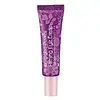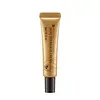What's inside
What's inside
 Key Ingredients
Key Ingredients

 Benefits
Benefits

 Concerns
Concerns

 Ingredients Side-by-side
Ingredients Side-by-side

Water
Skin ConditioningButylene Glycol
HumectantGlycerin
HumectantCyclomethicone
EmollientDimethicone
EmollientCyclopentasiloxane
EmollientPolysilicone-11
Isododecane
EmollientDimethicone Crosspolymer
Emulsion StabilisingCetyl Ethylhexanoate
EmollientCetyl PEG/PPG-10/1 Dimethicone
EmulsifyingCollagen
MoisturisingHyaluronic Acid
HumectantCaprylyl Glycol
EmollientEthylhexylglycerin
Skin ConditioningTropolone
Skin ConditioningTheobroma Cacao Extract
Skin ConditioningArgania Spinosa Kernel Oil
EmollientMangifera Indica Seed Butter
Skin ConditioningAdenosine
Skin ConditioningBeta-Glucan
Skin ConditioningRubus Idaeus Fruit Extract
AstringentCopper Tripeptide-1
Skin ConditioningIris Florentina Root Extract
MaskingHoney Extract
HumectantSodium PCA
HumectantBetaine
HumectantSorbitol
HumectantGlycine
BufferingAlanine
MaskingProline
Skin ConditioningSerine
MaskingThreonine
Arginine
MaskingLysine
Skin ConditioningGlutamic Acid
HumectantButyrospermum Parkii Butter
Skin ConditioningOlea Europaea Fruit Oil
MaskingHelianthus Annuus Seed Oil
EmollientLimnanthes Alba Seed Oil
Skin ConditioningDisodium EDTA
Water, Butylene Glycol, Glycerin, Cyclomethicone, Dimethicone, Cyclopentasiloxane, Polysilicone-11, Isododecane, Dimethicone Crosspolymer, Cetyl Ethylhexanoate, Cetyl PEG/PPG-10/1 Dimethicone, Collagen, Hyaluronic Acid, Caprylyl Glycol, Ethylhexylglycerin, Tropolone, Theobroma Cacao Extract, Argania Spinosa Kernel Oil, Mangifera Indica Seed Butter, Adenosine, Beta-Glucan, Rubus Idaeus Fruit Extract, Copper Tripeptide-1, Iris Florentina Root Extract, Honey Extract, Sodium PCA, Betaine, Sorbitol, Glycine, Alanine, Proline, Serine, Threonine, Arginine, Lysine, Glutamic Acid, Butyrospermum Parkii Butter, Olea Europaea Fruit Oil, Helianthus Annuus Seed Oil, Limnanthes Alba Seed Oil, Disodium EDTA
Water
Skin ConditioningSnail Secretion Filtrate
Skin ConditioningGlycerin
HumectantButylene Glycol
HumectantNiacinamide
SmoothingLimnanthes Alba Seed Oil
Skin ConditioningCetearyl Olivate
Glyceryl Stearate
EmollientSorbitan Olivate
EmulsifyingSqualane
EmollientOctyldodecyl Myristate
EmollientCetearyl Alcohol
Emollient1,2-Hexanediol
Skin ConditioningDimethicone
EmollientPEG-100 Stearate
Synthetic Beeswax
Emulsion StabilisingPolyacrylate-13
Palmitic Acid
EmollientPolyisobutene
Stearic Acid
CleansingEthylhexylglycerin
Skin ConditioningAdenosine
Skin ConditioningPolysorbate 20
EmulsifyingSorbitan Isostearate
EmulsifyingDisodium EDTA
Betula Alba Juice
AstringentPortulaca Oleracea Extract
Skin ConditioningPrunus Amygdalus Dulcis Seed Extract
Skin ConditioningSodium Hyaluronate
HumectantPalmitoyl Tripeptide-5
Skin ConditioningCopper Tripeptide-1
Skin ConditioningPhenoxyethanol
PreservativeWater, Snail Secretion Filtrate, Glycerin, Butylene Glycol, Niacinamide, Limnanthes Alba Seed Oil, Cetearyl Olivate, Glyceryl Stearate, Sorbitan Olivate, Squalane, Octyldodecyl Myristate, Cetearyl Alcohol, 1,2-Hexanediol, Dimethicone, PEG-100 Stearate, Synthetic Beeswax, Polyacrylate-13, Palmitic Acid, Polyisobutene, Stearic Acid, Ethylhexylglycerin, Adenosine, Polysorbate 20, Sorbitan Isostearate, Disodium EDTA, Betula Alba Juice, Portulaca Oleracea Extract, Prunus Amygdalus Dulcis Seed Extract, Sodium Hyaluronate, Palmitoyl Tripeptide-5, Copper Tripeptide-1, Phenoxyethanol
Ingredients Explained
These ingredients are found in both products.
Ingredients higher up in an ingredient list are typically present in a larger amount.
Adenosine is in every living organism. It is one of four components in nucleic acids that helps store our DNA.
Adenosine has many benefits when used. These benefits include hydrating the skin, smoothing skin, and reducing wrinkles. Once applied, adenosine increases collagen production. It also helps with improving firmness and tissue repair.
Studies have found adenosine may also help with wound healing.
In skincare products, Adenosine is usually derived from yeast.
Learn more about AdenosineButylene Glycol (or BG) is used within cosmetic products for a few different reasons:
Overall, Butylene Glycol is a safe and well-rounded ingredient that works well with other ingredients.
Though this ingredient works well with most skin types, some people with sensitive skin may experience a reaction such as allergic rashes, closed comedones, or itchiness.
Learn more about Butylene GlycolCopper Tripeptide-1 (GHK-Cu) is a skin repairing ingredient known for its ability to boost collagen, improve firmness, and support skin regeneration.
It is a complex made up of a naturally occurring peptide (glycine-histidine-lysine) and copper, an essential trace element.
While studying wound healing, researchers noticed GHK-Cu stimulated hair follicle enlargement and growth by keeping hair in its active growth phase longer. This has made it a promising ingredient for hair regrowth treatments.
Some people have reported increased facial hair. While GHK-Cu can make your hair follicles bigger, it usually doesn’t turn soft, barely-visible facial hairs into thick, dark ones.
Anecdotal reports suggest that overusing copper peptides might lead to premature aging due to excess free copper or enzyme imbalances. This claim isn’t backed by large-scale studies.
Unfortunately, there are limited human studies for this ingredient. While early results are promising, many studies are either small, in-vitro, or not rigorously controlled.
For example, there is a 1998 study that explored the effects of copper tripeptide, vitamin C, tretinoin, and melatonin on skin repair and collagen synthesis.
After one month, increased procollagen production was seen in 7 out of 10 participants using copper tripeptide (more than those using vitamin C, melatonin, or tretinoin.
While the study was exploratory, it offers early evidence that copper tripeptide may support collagen production. Larger, well-designed trials are still needed to confirm its potential and understand individual responses.
Read more about other common types of peptides here:
Learn more about Copper Tripeptide-1Dimethicone is a type of synthetic silicone created from natural materials such as quartz.
What it does:
Dimethicone comes in different viscosities:
Depending on the viscosity, dimethicone has different properties.
Ingredients lists don't always show which type is used, so we recommend reaching out to the brand if you have questions about the viscosity.
This ingredient is unlikely to cause irritation because it does not get absorbed into skin. However, people with silicone allergies should be careful about using this ingredient.
Note: Dimethicone may contribute to pilling. This is because it is not oil or water soluble, so pilling may occur when layered with products. When mixed with heavy oils in a formula, the outcome is also quite greasy.
Learn more about DimethiconeDisodium EDTA plays a role in making products more stable by aiding other preservatives.
It is a chelating agent, meaning it neutralizes metal ions that may be found in a product.
Disodium EDTA is a salt of edetic acid and is found to be safe in cosmetic ingredients.
Learn more about Disodium EDTAEthylhexylglycerin (we can't pronounce this either) is commonly used as a preservative and skin softener. It is derived from glyceryl.
You might see Ethylhexylglycerin often paired with other preservatives such as phenoxyethanol. Ethylhexylglycerin has been found to increase the effectiveness of these other preservatives.
Glycerin is already naturally found in your skin. It helps moisturize and protect your skin.
A study from 2016 found glycerin to be more effective as a humectant than AHAs and hyaluronic acid.
As a humectant, it helps the skin stay hydrated by pulling moisture to your skin. The low molecular weight of glycerin allows it to pull moisture into the deeper layers of your skin.
Hydrated skin improves your skin barrier; Your skin barrier helps protect against irritants and bacteria.
Glycerin has also been found to have antimicrobial and antiviral properties. Due to these properties, glycerin is often used in wound and burn treatments.
In cosmetics, glycerin is usually derived from plants such as soybean or palm. However, it can also be sourced from animals, such as tallow or animal fat.
This ingredient is organic, colorless, odorless, and non-toxic.
Glycerin is the name for this ingredient in American English. British English uses Glycerol/Glycerine.
Learn more about GlycerinLimnanthes Alba Seed Oil is the oil extracted from the seeds of the meadowfoam plant. This oil is non-fragrant and is an emollient. As an emollient, meadowfoam seed oil helps soften and hydrate the skin.
Meadowfoam seed oil is stable and has a long shelf life due to its chemical structure. It has the highest concentration of stable fatty-acids among plant oils, preventing it from degrading once exposed to oxygen.
Due to the fatty acid content, this ingredient may not be fungal-acne safe.
Meadowfoam is native to California and Oregon.
Learn more about Limnanthes Alba Seed OilWater. It's the most common cosmetic ingredient of all. You'll usually see it at the top of ingredient lists, meaning that it makes up the largest part of the product.
So why is it so popular? Water most often acts as a solvent - this means that it helps dissolve other ingredients into the formulation.
You'll also recognize water as that liquid we all need to stay alive. If you see this, drink a glass of water. Stay hydrated!
Learn more about Water